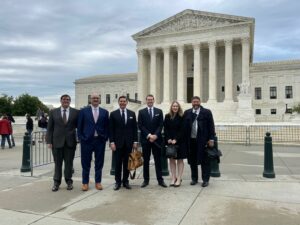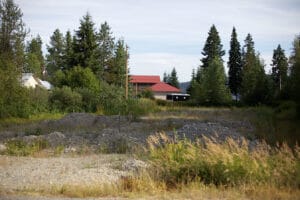States, congressmen, farmers, and builders file amicus briefs in support of the Sacketts

On Monday, October 3, Pacific Legal Foundation senior attorney Damien Schiff will argue Sackett v. EPA at the Supreme Court. At issue is the scope of the Environmental Protection Agency’s authority to regulate wetlands under the Clean Water Act.
More than 350 organizations, states, and members of Congress have filed amicus briefs in support of the Sacketts, an Idaho couple who’ve been battling the EPA for 15 years for the right to build a home on a residential lot.
While the organizations and individuals filing amicus briefs are from different areas of the country and work in different industries, their messages to the Court touch on many of the case’s key themes:
-
- For decades, the EPA and the Army Corps of Engineers have defined the CWA’s key jurisdictional phrase—“waters of the United States”—beyond what Congress intended, in order to expand their own power and aggrandize their jurisdictional authority.
- The agencies’ failure to adopt a workable definition of “waters of the United States” that clearly delimits the Act’s reach has frustrated both the regulated public and the federal courts.
- The agencies’ ever-expanding definition of “waters of the United States” violates Congress’s intent in the CWA to preserve the states’ traditional authority over the use and development of land and aquatic resources.
- Sound environmental policy and regulation do not require the limitless expansion of federal government power.
- The “significant nexus” test—which the agencies and some lower courts have employed to establish federal jurisdiction over wetlands—should be abandoned because it leaves millions of American property owners and businesses uncertain about how they’re legally allowed to use their land.
See all the amici supporting the Sacketts with selected excerpts below:
West Virginia and 25 other states
“If the CWA applies to any damp piece of land with an indeterminate ‘nexus’ to interstate waters, then the Constitution’s and the statute’s balance among the sovereigns will come askew.”
State of Alaska
“Water that is not a ‘water of the United States’ is not, for that reason, unprotected. Instead, it is protected by state rather than federal law. Greater state authority over waters would not undermine the Act’s objective to ‘restore and maintain the chemical, physical, and biological integrity of the Nation’s waters,’ 33 U.S.C. § 1251(a)—it would simply leave space for a different government body to further this objective. States have the prerogative and incentive to fill this space and to balance their power with facilitating local needs.”
Americans for Prosperity Foundation
“This case is not about what constitutes sound environmental policy. Instead, it is about EPA’s longstanding efforts to circumvent statutory and constitutional limits on its regulatory power under the CWA by reimagining the statutory phrase ‘waters of the United States’ to encompass, among other things, parcels of land suitable for homebuilding, as happened here. EPA’s regulatory approach is inconsistent with the ordinary meaning of the statute and violates the structural limitations of federalism and separation of powers, as well as infringing due process.”
Forestry Organizations
“Since 1975, the Government’s interpretations of “navigable waters” have operated as a one-way ratchet to expand federal regulatory authority under the CWA … Those interpretations reached this Court on three occasions. Win or lose, the Government responded the same way after each case: turn the ratchet again.”
Cato Institute, Associated General Contractors of America, Mountain States Legal Foundation, NFIB Small Business Legal Center, and Washington Legal Foundation
“For a statute that touches on millions of acres of land, the lack of clarity is both dismaying and counterproductive.”
Property and Environment Research Center
“In the past …. [the significant nexus] test has been justified on the assumption that broader federal jurisdiction is more conducive to the statute’s purpose of ‘restor[ing]and maintain[ing]the chemical, physical, and biological integrity of the Nation’s waters. …’ Such assumption merits caution. … Clarity and administrability, rather than the breadth of federal jurisdiction alone, are critical factors for whether a test advances the statute’s purpose. A vague test can cause federal enforcement efforts to be unfocused or haphazard, make wetlands a liability for private landowners, and breed ill will between landowners, conservation interests, and regulators. …”
Southeastern Legal Foundation
“Complying with the law should not be this hard. Waters of true federal significance should be obvious. Properties should be bought, sold and developed without undergoing months or even years of expert analysis. And people should understand the rules before they are fined and prosecuted. These are foundation aspects of our private property and due process rights. The Agencies and the regulated community needs this Court’s direction to rein in the behemoth WOTUS problem that has unfolded over the last few decades.”
Liberty Justice Center
“That these definitions bounce back and forth from administration to administration, representing not a coherent policy of Congress but the whim of executive preference, further renders the agencies’ authority suspect.”
Congressional Western Caucus
“Continued federal expansion into environmental protection and conservation will box out and preempt more effective, responsive state and local efforts.”
National Stone, Sand & Gravel Association and the American Road & Transportation Builders Association
“The fundamental problem with ‘significant nexus,’ a term that does not appear anywhere in the Clean Water Act, is that it has no inherent limiting principles. It empowers the agencies to assert CWA jurisdiction over any wetland adjacent to a water feature with an intermittent, remote, or indirect connection to a navigable water and expands CWA jurisdiction well beyond the limits set by Congress.”
Atlantic Legal Foundation, Conservatives for Property Rights and Committee for Justice
“Throughout the United States there are countless other landowners who, like Petitioners, are knowingly (or unknowingly) precluded from using their property in any economically viable way because of the federal government’s expansive view of wetlands.”
14 National Agricultural Organizations
“Without clarity about the meaning of WOTUS, farm operations carry the risk of substantial civil penalties, criminal fines and imprisonment for even negligent violations, and costly-to-defend suits by environmental activists. …. Avoiding those risks means foregoing all practical use of an area of a farm that might be WOTUS—for the Agencies may treat even building a fence in a wetland as a violation of the CWA, let alone moving dirt, spreading fertilizer, or other active farming.”
Associated Industries of Florida and the Florida H20 Coalition
“By broadly empowering EPA and the Corps to assert federal authority over any wetland or surface water with even a remote theoretical connection to traditional navigable waters, the significant nexus test interferes with the traditional state and local power. It coerces applicants acquiesce to federal jurisdiction to avoid the expense and time of determining what constitutes a significant nexus, and to avoid lengthy and costly battles and litigation.”
National Association of Home Builders of the United States
“Unfortunately, the boundaries of the CWA have been constantly changing due to the ‘significant nexus’ test developed in Rapanos v. United States, 547 U.S. 715 (2006) and as interpreted by the government. These everchanging rules make it more costly for developers to purchase and develop land and these costs in turn make it difficult to provide homes that the public can afford.”
Chamber of Commerce of the United States of America
“A clearly delineated reading of ‘waters of the United States’ is critical for business and consistent with environmental protection. The reality is that permitting costs can and do inhibit project development, including important climate, clean energy, resilience, and water management projects. A clear and predictable understanding of ‘waters of the United States’ is needed to reduce these substantial costs and to ensure that they are not imposed more broadly than required.”
Wyoming Stock Growers Association, Wyoming Association of Conservation Districts, and Progressive Pathways
“[T]he practical effects of not knowing whether one’s lands or activities may fall within the auspices of the Clean Water Act are costly. Decades of ambiguous and subjective jurisdictional determinations have created significant uncertainty for landowners who are required to comply with the Clean Water Act as it is currently being applied by the agencies.”
Savannah Economic Development Authority, Greenland Developers, LLC, and Resource & Land Consultants, LLC
“[T]he persistent uncertainty has added hundreds of millions of dollars or more in permitting costs and frustrated—even prevented—warehousing and infrastructure development, compounding post-pandemic supply-chain constraints.”
The Claremont Institute’s Center for Constitutional Jurisprudence
“This case demonstrates that the Environmental Protection Agency and the Army Corps of Engineers have pulled off a naked power grab. Not only have they usurped the power of Congress to make the laws and the power of the courts to interpret those laws, but they have also usurped state and local governments’ police power authority to regulate local land use.”
Farm Bureau of Arkansas and 19 Others
“In the decades since the CWA’s enactment, however, the federal government has attempted to increase its authority by regulating features that are wholly intrastate and that often are not recognizable as water bodies at all, deeming them against both plain text and commonsense to constitute ‘waters of the United States.’”
Duarte Nursery, Inc.
“The ‘significant nexus’ test and the Corps assertions of jurisdiction unconstitutionally impose on a lay person a duty found nowhere at common law—a duty to retain a bevy of experts including an attorney, biologist, geologist, hydrologist, and countless others—to attempt to determine what the Act means before using their private property.”
American Exploration & Mining Association and 11 Other Mining Associations
“There is simply nothing in the text of the statute or in its legislative history to suggest Congress intended to exercise federal jurisdiction over all areas from which water molecules might someday travel to a navigable-in-fact water.”
Sen. Shelley Moore Capito, Rep. Sam Graves, and a Coalition of 199 Members of Congress
“In the CWA, Congress selected language that, from practically the Founding, was understood both to exercise limited jurisdiction and to preserve the State’s traditional role as the principal regulators of local waters and lands. But this intent has now been turned on its head. Through the ‘significant nexus’ test, the EPA and the Corps can use any ecological connection between land and nearby water as a pretext for intrusive central planning. This case presents an opportunity for the Court to finally put the genie back in the bottle …”
American Petroleum Institute, Association of Oil Pipelines, American Gas Association
“The absence of a clear rule as to what lands are in and what lands are out is not just a good-governance problem. It is detrimental to the Clean Water Act’s success. In order to protect ‘waters of the United States,’ the statute requires regulated parties to obtain a permit before engaging in certain activities on covered property—and imposes severe civil and criminal penalties for a party’s failure to do so. If regulated parties lack adequate notice that their property is subject to the Act, they run the risk of damaging protected waters and exposing themselves to crippling liability in the process.”
National Cattlemen’s Beef Association and Affiliated Organizations
“The impact of the significant nexus test to landowners relies almost entirely on how it is interpreted and applied by individual regulators. Regulated stakeholders have little opportunity clearly know what is prohibited because they are subject to the arbitrary application of an unclear standard.”
Association of American Railroads
“Agencies cannot change a statute’s meaning years later by adopting rules that introduce new terms and use them in unnatural ways.”
Freeport-McMoRan Inc.
“[R]egulated entities, States, and federal regulators all need a clearer and more easily-administrable standard in this notoriously unsettled area.”
Find more links and materials related to Sackett v. EPA—including a case timeline and photo library—here.









